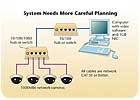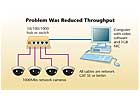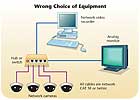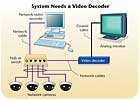A system that uses a digital video recorder (DVR) with analog cameras is still basically an analog system with digital recording. In a DVR, the videotape of a VCR is replaced with hard drives for the video recording, which requires the video to be digitized and compressed in order to store as many days’ worth of video as possible. With early DVRs, hard disk space was limited, so recording duration was limited or a lower frame rate had to be used. Recent development of hard disks and compression techniques means space is no longer a major problem.
Network video systems, often referred to as IP surveillance, is a fully digital system that gives users the ability to monitor and record video over an IP network (LAN/WAN/Internet) using standard network cabling and network hardware. Unlike analog video systems, network video uses the network, rather than dedicated point-to-point cabling, as the backbone for transporting information. In a network video application, digitized video streams are transferred to any location in the world via a wired or wireless IP network.
To determine your knowledge of digital video systems, take the following 20-question quiz. Then scroll to the bottom and find out how you scored.
1. Network cameras incorporate intelligence at the camera level.
a. True
b. False
2. What types of signals can network cameras transmit/receive using a single net-work cable?
a. Video
b. Audio
c. PTZ controls
d. All of the above
e. None of the above
3. What information can a network camera add to the video data stream?
a. NVR model number and type
b. Encrypted watermarks
c. Lighting conditions
d. All of the above
e. None of the above
4. The image from an IP camera using a CCD sensor is digitized.
a. once
b. twice
c. three times
d. All of the above
e. None of the above
5. Analog cameras can encrypt the video signal.
a. True
b. False
6. How far can an IP camera connected to the Internet send video to a NVR connected at a remote Internet connected location?
a. 1000 feet
b. 10 miles
c. Unlimited distance
d. All of the above
e. None of the above
7. The images from analog cameras are digitized three times from the time they are captured until they are recorded.
a. True
b. False
8. IP cameras can send video signals using regular network infrastructure.
a. True
b. False
9. Today’s NVRs now embody features such as
a. hard disk temperature monitor.
b. hot-swappable disks.
c. file export function which embodies the
watermarking and digital signature.
d. All of the above
e. None of the above
10. Most IP cameras have integrated motion detection capabilities.
a. True
b. False
11. What features are typical when using an NVR?
a. They always contain capture cards/
frame grabbers.
b. Channel expansion always requires hardware upgrade.
c. They are normally limited to 16 channels.
d. All of the above
e. None of the above
12. You can have multiple NVRs on the same network recording the same cameras.
a. True
b. False
13. Which advantages do NVR surveillance systems offer?
a. Scalability
b. More cost-efficient infrastructure
c. Intelligence at camera level
d. All of the above
e. None of the above
14. In standard Cat5 cabling for 10Mbit or 100Mbit Ethernet which pins are used for PoE (Power over Ethernet)?
a. 1, 2 and 7, 8
b. 3, 4 and 5, 6
c. 1, 2 and 5, 6
d. All of the above
e. None of the above
15. In NTSC, which of the following statements regarding CIF (Common Intermediate Format) are true?
a. In NTSC CIF means 352 x 240 pixels.
b. In NTSC the maximum size of the digitized image is 4CIF.
c. 4CIF equals 0.4 megapixels.
d. All of the above
e. None of the above
16. What amount of light is considered a “full daylight condition”?
a. 100 lux
b. 1000 lux
c. 10,000 lux
d. All of the above
e. None of the above
17. Most IP cameras require a separate cable run for power and/or PTZ.
a. True
b. False
18. In order to have two or more IP cameras connected to a NVR you must have a network router.
a. True
b. False
19. Analog cameras are limited to 2 megapixels in resolution.
a. True
b. False
20. IP surveillance systems can operate over a
a. LAN (local area network).
b. WAN (wide area network).
c. wireless network Infrastructure.
d. All of the above
e. None of the above

System Needs More Careful Planning
The security industry’s bane installer, Wally ‘Larman, installed a video surveillance system with IP cameras and a NVR, using the existing network cables and configuration. For maximum throughput he selected 1000 Mbs cameras and NVR, and for ease of installation he connected the cameras and NVR to the closest hubs, as shown in this diagram. When the system was tested the client was not satisfied with its overall performance. Can you see what Wally can do to make the system work better and be more flexible?
Wrong Choice of Equipment
Wally ‘Larman installed an IP-based system that required a spot monitor to display a live image from one of the installed cameras. Because the system was IP based, Wally ran all network connections as shown in this diagram but had a problem connecting the analog monitor. What should Wally have done to properly install the system?Answers
Stop! If you haven’t already taken our 20 Questions quiz, then turn return to the top of the page. If you have, then get ready to score yourself and learn something in the process. Although 20 Questions is not accredited by an official learning institution, we’ve created a scoring guide anyway, just for fun.Number of correct answers rating
20 Excellent
18-19 Very good
16-17 Good
14-15 Average
12-13 Below average
11 or fewer Poor
1. a — The advanced network cameras can have standard built-in motion detection and alarm management so the camera decides when to send video, at what frame rate and resolution, and when to alert a specific operator for monitoring and/or response.
2. d — Network camera technology enables PTZ control over the network that transports video and audio.
3. b —Network cameras can add encrypted watermarks to the video data stream with information on image, time, location and alarms.
4. a — In the network camera system, images are digitized once and they stay digital for the duration; no unnecessary conversions and no image degradation.
5. b — With an analog camera, the video signal is transported over a coaxial cable without any encryption or authentication.
6. c — Connected to the Internet there is no distance limit for a camera to transmit to the NVR.
7. a — The CCD sensor in an analog camera generates an analog signal that is digitized by an A/D converter to make possible the image-improving function in a DSP. The signal is then converted back to analog for transport over a coaxial cable. Finally, at the DVR the signal is once again digitized for recording. That makes a total of three conversions.
8. a — IP cameras can connect to any in-network standard hub, switch or router without special equipment.
9. d
10. a
11. e — They do not need a capture card because the encoding is done at the camera, channel expansion frequently by software license, and you can connect an unlimited number of cameras within the restrictions of the hardware.
12. a — Mirroring techniques are often used to duplicate the recording of other NVRs installed in different points in network.
13. d
14. e — Pins 4, 5 and 7, 8 are used. Intel, Ayaya, Orinoco, Wavelan, 3Com and Symbol use 4, 5 = ground and 7, 8 is positive.
15. d
16. c — “Full daylight condition” environment is when there is approximately 10,000 lux. Normal office light represents around 500 lux.
17. b
18. b — Any hub or switch also can do the job.
19. b — Analog cameras are fixed at NTSC/PAL specifications, with a resolution corresponding to about 0.4 megapixel at 4CIF.
20. d

Answer to: System Needs More Careful Planning
The problem is that Wally installed a network video system with 1000 Mbs capability, but connected the NVR to a hub that was only rated at 100 Mbs. This reduced the throughput to the NVR. Wally should connect the NVR to the same hub that the cameras are using, as shown in this diagram, or replace the 100 Mbs hub with a 1000 Mbs unit, because the NVR has a NIC that supports up to 1000 Mbs and the hub that cameras are connected to supports the same speed. In order to use the maximum transfer speed between cameras and NVR he should keep the NVR in the same segment of LAN speed.
Answer to: Wrong Choice of Equipment
Analog monitors cannot be connected using network cables. In order for an analog monitor to operate, Wally needs a video decoder, which will convert the digital signals to analog. He must also run coaxial cable between the video decoder and the analog monitor as shown in this diagram.It is very important when you are designing a system to make sure that all components are capable of working together and that you have run the correct cables to each device.


